
Pokémon TCG Pocket Needs These Three Things From Marvel Snap
Pokémon TCG Pocket arrived this week on iPhone and Android, and it’s a surprisingly crisp and streamlined version of the card game after years of really bad alternatives. Pokémon is pretty much a license to print money, but TCG Pocket does a great job of spotlighting what people love about about the game—the cards themselves—and getting most of the other stuff out of the way. Still, as a big fan of Marvel Snap, there are a few things I wish the mobile game would steal from Second Dinner’s 2022 comic book phenomenon.
I’ve been spending most of my idle smartphone moments the past two days playing Pokémon TCG Pocket instead of doom scrolling Twitter or ingesting AI-slop on Instagram, which is exactly what I want from a good, daily grind mobile game. All of the currencies and sub-economies aimed at getting you to spend money on the otherwise free-to-play game are a bit convoluted and hard to parse, but the battles are fun and opening virtual booster packs by slicing wrappers with a finger swipe is a surprisingly effective simulacrum of the pure joys of doing so in real life.
I’m not yet as obsessed with Pokémon TCG Pocket as I was with Marvel Snap, however, and I think there are three reasons for that. The first is match length. Marvel Snap battles breeze by, making it feel relatively low-stakes to start up another no matter what’s going on around you. TCG Pocket is a bit more involved. Players have a cumulative timer of 20 minutes, with countdowns starting at over 60 seconds for individual turns. The clock rarely gets milked, but matches can still feel a little drawn out as players stack their benches and build up their Pokémon’s power. More than once I’ve finished a match and thought, “That was neat but do I really have time for another.”
The second thing holding Pokémon TCG Pocket back a little for me are the match rewards. In addition to bite-sized matches, Marvel Snap has an ingenious progression built around acquiring extra cards to level them up and earn points that can be spent on acquiring new ones. It’s a clever twist on the traditional booster pack RNG formula. TCG Pocket, as an adaptation of an existing card game, doesn’t have that same luxury. Unfortunately, as things stand, the only rewards for winning matches are miniscule amounts of XP that contribute to an overall level. Raising it nets additional rewards but none of them feel very distinct. The result is that finishing matches feels a bit anti-climactic, rather than giving out that dopamine hit that makes you immediately want to play another match.
Finally, there’s the cards themselves. Outside of building your collection, Marvel Snap has the secondary goal of acquiring, sometimes by outright purchasing, cool alternate card art for your favorite decks. It provides something else to strive for as well as a way to express your particular flavor of popular deck type. Again, TCG Pocket runs into trouble here because its working off of existing card art, and while there are multiple versions of certain cards to unlock, there aren’t many, and there’s no real way to chase them directly. If you open a pack and get a full art variant, great! If not, well, wait for the next random pull.
It’s still early and TCG Pocket is otherwise doing a lot right, certainly more than probably every other digital version of the Pokémon card game I’ve played in the past. There’s only one set of cards to collect at the moment and not much eye candy to salivate over in the paid in-game store. I’m sure that will all change soon enough but for now the game hasn’t quite conjured the full magic of my early days with Marvel Snap. Maybe that’s for the best. I eventually had to delete that game from my phone because it was consuming way too much of my free time.

Pokémon TCG Pocket Already Feels Like A Well-Laid Trap
I’m really averse to trading card games. Despite loving me some Pokémon and Yu-Gi-Oh as a kid and tween, I’ve largely kept my distance from them in the time since. I’ve played a few hands of Hearthstone, I never touched Artifact, and I am straight-up dogshit at any card game baked into an RPG, except for Queen’s Blood in Final Fantasy VII Rebirth. Maybe it’s all the stories I’ve seen of players spending exorbitant amounts of money to pull rare cards from booster packs, but the pastime seems dominated by greed and status more than the fun of the tactics and interplay between cards that I always valued.
It’s for reasons like these that I didn’t start playing Magic: The Gathering until a few weeks ago. I was going on vacation and knew I’d be around folks who play the game, so I relented and tried it. Unsurprisingly, I found that Magic is deeply fun and rewarding, but when I texted my roommate who plays the game, he warned me of the cost of it all. As did my best friends when I shared that I’d successfully been Magic-pilled. Of course, that did little to stop us from heading to a shop hosting a ludicrous sale on singles, purchasing about $45 worth of cards I simply thought looked cool, and playing another few games before I left town. My first go was a bit rough around the edges, but by the second game, I’d already been able to take out another player in a fashion that even impressed me!
With that experience in mind, as well as a single (and might I mention, triumphant) game of the Pokémon TCG under my belt, I took the plunge into Pokémon TCG Pocket, the mobile and gacha-infused adaptation of the popular card game that has ravaged my friends and their wallets the last few years. Unfortunately, it’s good, bite-sized fun, and it feels like a trap.
The slow tutorial of Pocket does a great job of introducing the fundamentals: play and evolve Pokémon, attach energies to use devastating attacks, and use items and other support cards to pull cards from your deck and keep your critters standing. There’s more to know, like retreating, benched Pokémon, abilities, and so on, but Pocket is actually a wonderful place to start if you’re looking to get into the actual card game. It plies you with prebuilt decks and solo challenges that’ll familiarize you with the ebb and flow of battle in increasingly difficult increments, eventually letting you challenge other players. Bouts in these modes are pretty generously timed, making them perfect for beginners who are dipping their toes in for the first time, and the winner is the first to three KOs, which happens quicker than you might expect. It’s no Marvel Snap, but fights in Pocket aren’t exactly drawn out like they can be in the anime or video games.
However, all of this is secondary to Pocket’s real allure and danger. Its home screen consists of a bunch of icons, buttons, and panels, but the three biggest ones in the center of the screen are booster packs, a feature called Wonder Pick, and a shop. Let’s work our way down.
First up, the booster packs: there are currently three available, all within a larger promo called Genetic Apex, and they’re centered on Pikachu, Charizard, and Mewtwo. (You can pick between the three packs at any time and it’s free to open one.) Clicking on the panel brings you to a screen where you can preview the offerings inside each pack, and cracking them is how you first gain literally any XP in the game. Before you do anything, even battling, you must open a booster pack and become familiar with Pocket’s many currencies and systems.
For example, slicing open a pack, which comes complete with a satisfying sound and vibration from your phone, generates pack points, which can then be spent on picking out single cards that range in value depending on their artwork, whether they’re holographic or not, and more. The most prominent of these currencies, though, are Pocket’s hourglasses.
Underneath both the booster packs and Wonder Pick icons are timers. The one under the former is counting down to the next time you are allowed to crack a pack—you can snag two each day, or one every 12 hours basically— and the latter’s timer is counting down to the next charge of a Wonder Pick, which can hold five charges max. The Wonder Pick allows you to spend charges to select a randomized card from booster packs that random players or your friends have recently opened. (Don’t worry, they won’t lose the card.) Say someone gets a uniquely good haul. You can then spend an appropriate amount of Wonder Pick charges—which will scale with the value of the cards included—to kind of get a chance at at least one high-value pick!
At the moment, I have two Wonder Pick charges, with a third being restored within the next eight hours. That limits the packs that I can freely pick from, meaning I can do a trio of poorly rated drops, try my hand at a slightly better one costing two charges, or wait and see if I can pull one for three. Of course, these agonizingly long waits can be reduced by simply using hourglasses, which cut down timers by an hour per unit, and the game is sure to remind you of what you’re missing out on by featuring the extravagant pulls of everyone you know on the Wonder Pick page.
The early leveling experience and tutorial also make you flush with hourglasses, to the point where I was in the hundreds within about an hour of playing. It wants you to spend those hourglasses so badly to speed up the booster pack timing, reward you with some paltry offerings and a lone full art or EX card, and then hook you on that high. There’s also already an offer in the game to upgrade to a premium pass that allows you to open a third pack a day for two weeks with no charge and access premium missions with more rewards, like card sleeves, playmats, coins, and as of this moment, even an exclusive full-art Pikachu card. The obvious hope is that you’ll forget to cancel and lapse into becoming a full-blown sub, or worse, willingly offer it because you’re that hooked.
None of these systems explicitly get in the way of you just hopping into solo or online battles, but already, I’ve run into scenarios where I’ve just narrowly eked out victories over players who’ve obviously spent the dough (or just gotten lucky enough) to pull EX Mewtwos and the like. Meanwhile, I’m using fairly rudimentary decks and building my Pokedex and binder very slowly by comparison. While surveying the cards that friends of mine had pulled, I actually felt a pang of jealousy so great that I used hundreds of hourglasses to splurge on ten booster packs, which yielded me a lot of cards, but ultimately a whole bunch of nothing.
Pocket, just like the base TCG and every gacha and service game in the world, is banking on its systems to create these kinds of frustrations—these pockets of FOMO, if you will—and push you to spend so you keep enjoying the game. And since this is Pokémon we’re talking about here, y’know, the biggest media property in the world, there’s no telling the damage it’ll ultimately wreak.
I’m also wary of investing too much into Pocket because, frankly, I’ve little trust in digital media anymore. Years of shows being cut from streaming services, as well as games getting delisted and pulled from players’ libraries, have been a stark reminder that these companies are more than happy to sell you empty promises. A physical card can at least be tucked into a sleeve or binder that you can safely put away and bring back out. The Criterion Collection movies I’ve been assembling in my entertainment center aren’t going anywhere unless I want them to. Those physical things, be they cards or movies, are things that will last with care, care that I and many others willingly give them.
So long as Pocket makes Nintendo and The Pokémon Company richer, it’ll be around. The moment it stops benefiting them materially, though, I’m sure they’ll have no problem taking it all away from us, and that awareness is inevitably going to color my experience with it.
Which is a shame, because I really am enjoying Pocket. It felt good getting to trounce that player with the Mewtwo by simply outsmarting and outplaying them. The TCG version of Pokémon will be mostly familiar to someone who’s played the games before, but there’s just enough of a tactical twist in the management of energies and the whole party to promote smart plays over raw power sometimes. It’s still very early days for Pocket, meaning it’s impossible to divine its staying power or whether all of the problems I’m flagging will remain as such. For as much joy as it might bring, just never forget to treat Pocket, as well as its developers and publishers, with the caution they deserve.
.
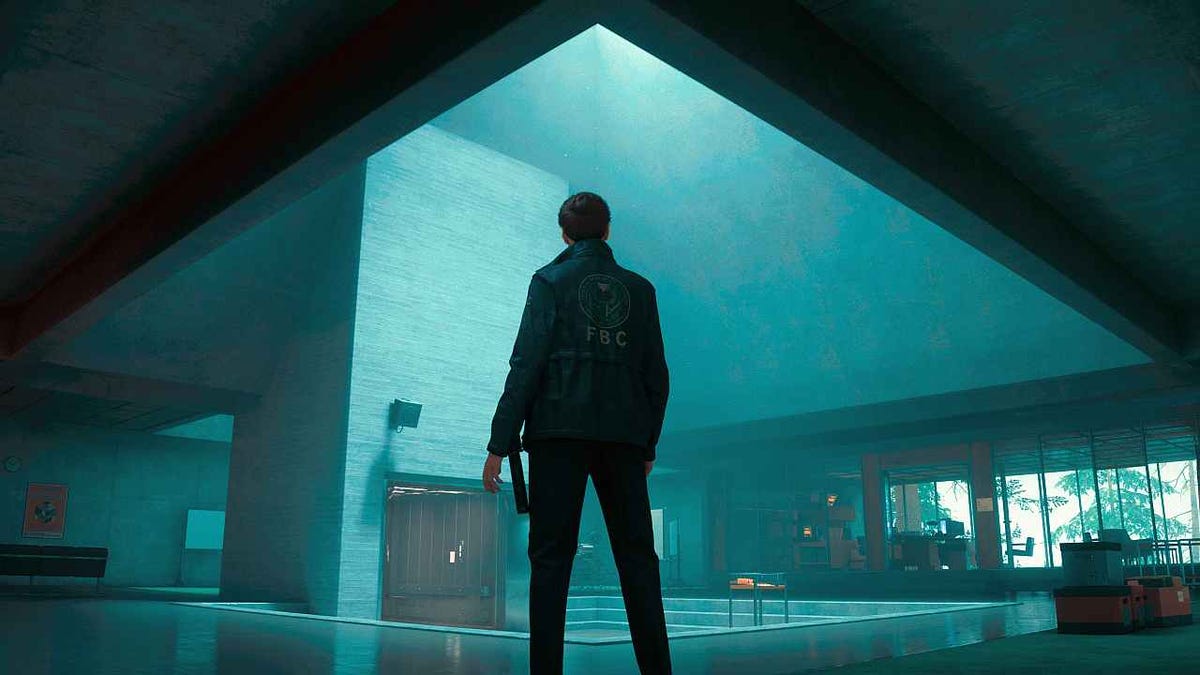
Alan Wake 2’s Final Expansion Is A Perfect Ending
After the crowning achievement that is Alan Wake 2, you’d think developer Remedy Entertainment would take a break. Yet in the subsequent expansions to the 2023 survival horror game, the studio has poked and prodded further at the base game’s thesis, teasing out even more fascinating aspects of its world. The Lake House, the final DLC for Alan Wake 2, does this poking with exceptional style and an eye towards discussing one of the industry’s hottest topics of debate: AI’s role in art. As a goodbye to one of the best AAA games in recent memory, it’s a triumph.
Those familiar with the base game might remember The Lake House’s protagonist, Kiran Estevez, as the Federal Bureau of Control agent who helps Saga along her journey. Told through narration, The Lake House recounts Estevez’s investigation into the titular location, an FBC facility that has gone dark. Like Night Springs, the first of AW2’s expansions, The Lake House is a bite-sized experience that will take you only two to three hours to complete. That’s perfect, as it lets Remedy tell a more concise story with a clear point of view.
Despite being more closely connected to 2019’s Control than anything else in AW2, don’t expect The Lake House to play like that supernatural action game. Estevez isn’t packing special powers, just a pistol and a flashlight. As in the base game, you’ll collect a few more weapons along the way (including an entirely new armament) to fight off the now-infected inhabitants of the Lake House. As a conclusion to the AW2 experience, The Lake House clearly wants to challenge you, boasting some tough fights against large groups of enemies made even tougher by a seemingly abysmal amount of resources throughout the facility. If you aren’t careful, you’ll find yourself with an empty clip and no other option than to face your inevitable death and restart with a better plan.
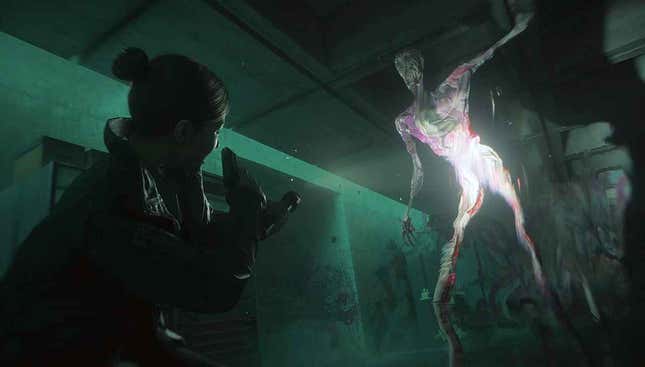
The expansion’s titular facility gives The Lake House its own aesthetic identity, one that’s far more in line with Control. This is an FBC building, after all, and as soon as you walk inside its concrete lobby, the sleek brutalist architecture might almost make you feel like you’re back in the Oldest House. The enemies you encounter within the facility, like the weapons you find, are mostly rehashes of what you saw in the base game, a bunch of zombie-like figures who’ve been infected by the Dark Place. There is, however, something else lurking within the Lake House: looming humanoid figures dripping with paint that jump out of canvases to kill you. The Lake House itself is decorated with countless paintings and graffiti across its walls (alongside lots of blood).
The physical art you encounter around every corner in the Lake House represents the facility’s (and the expansion’s) continued obsession with the artistic process. Unlike Wake himself, and many other important figures in the extended lore of the series, the major players in The Lake House are not artists themselves, yet they are preoccupied with the production of it. The competing co-heads of the facility, whose story The Lake House truly is, conducted experiments in an effort to harness Wake’s ability to reshape reality through art, a path which ultimately plunged the building into chaos.
As you explore the levels of the Lake House, you’ll read emails and memos about two dueling projects, both of which seek to quantify the emotion of an artistic piece in some objective manner that can then be replicated. One researcher attempts this by dragging in a painter and forcing him to adhere to an inhuman production schedule to create the correct art for triggering a supernatural power like Wake’s. The opposing project believed that it could recreate the outcome of Wake’s writing through observation, measurement, and replication.
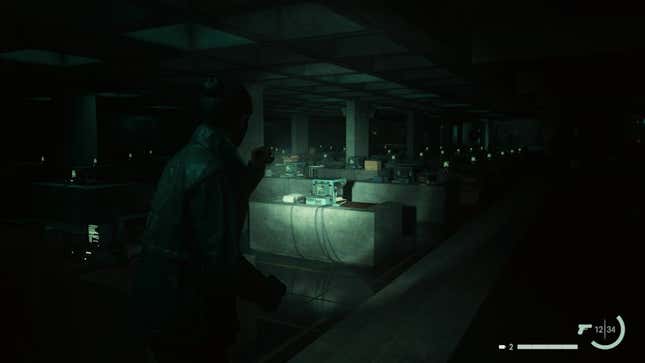
One of the most striking environments in The Lake House is a sprawling open office filled with dozens—maybe hundreds—of automated typewriters trained on pages written by Wake that the FBC recovered. The mechanical whirring of machines and cacophonous clicking of keys produces countless pages of text. In a room off to the side you can find a white board on which researchers graded each resulting page on metrics like tone, style, readability, etc. There is a constant desire to define what makes something “art.”
It’s a not-at-all subtle takedown of artificial intelligence in tech, specifically products like ChatGPT that scrape the work of real creators in order to produce empty facsimiles of art that impress only the most unimaginative people. Remedy beats you over the head with the sheer stupidity of both the Lake House experiments and their real-life counterparts. Signs plastered on the walls encourage workers to not decorate their desks and remind them that “art is for analysis.” At one point, a page written by Wake describing the projects within the Lake House reads “art was not art, just content for the experiment.”
That’s Alan Wake 2’s final message to audiences. Art is not content. It’s a word that’s become so much more prolific across cultural discussions in recent years as the proponents of AI push us toward conceiving of every piece of art as simply a product for viewer enjoyment rather than a thing that can challenge your worldview. Games are not content. Writing is not content. Art is not content. Those who create are not cogs in a machine to be used and disposed of or turned into food for an algorithm. The Lake House is Remedy’s clear statement that the push to quantify and replicate art without emotion is nothing short of a horror story. As far as farewells go, it’s a pretty fucking good one.
.

Prophecy And More November Movies And Shows
If you’re lucky enough to have witnessed the on-stage musical in all its glory, then you won’t want to miss part one of Wicked on November 27. The film features an exceptional cast, including Cynthia Erivo, Ariana Grande, Michelle Yeoh, and Jeff Goldblum. Wicked reimagines the age-old tale of The Wizard of Oz, following the Wicked Witch of the West and Glinda the Good Witch, two unlikely friends, as they traverse life-altering events and situations.
It’s a more authentically adult tale than the children’s movie, full of darkness, tragedy, and mishaps that, more than anything else, warn about unquestioningly loving and trusting those around us. If you’re not a fan of musicals, you’ll likely want to skip this one, as it’s a full-on, head-bopping fantasy.

Black Ops 6 Gives Xbox The W It’s Been Waiting For
Call of Duty Black Ops 6 is the first entry in the annual blockbuster to be announced and released since Microsoft acquired it along with the rest of Activision Blizzard last October. And, by all accounts, it’s giving Xbox the boost it needed during a rough year. On an earnings call this week, Microsoft CEO Satya Nadella called it the “biggest Call of Duty release ever.”
Order Call Of Duty: Black Ops 6: Amazon | Best Buy
The company revealed that Black Ops 6’s three-day launch had the most players, hours played, and total matches of any game in the two-decade-old military shooter series. Nadella added during the call that the game set a record for “Game Pass subscriber adds on launch day,” and that sales were up 60 percent on PlayStation and Steam from last year’s Modern Warfare 3.
“This speaks to our strategy of meeting gamers where they are by enabling them to play more games across the screens they spend their time on,” Nadella said. In addition to being the first entry in the series to launch day one on a subscription service, Black Ops 6 is the first to be supported with cloud gaming. There was also no early access period for the single-player campaign, and no exclusive content or perks for PlayStation users. The whole series recently hit over 500 million sales, and an Activision exec told the Washington Post that the structure of how Call of Duty is made “won’t change” under Microsoft.
We still don’t have any hard numbers. Microsoft is a black box when it comes to sales data. There is no total player count or sales figure to try and chart Black Ops 6‘s success, and we don’t know how many more Game Pass subscribers joined the $20-a-month tier to play it as part of the free Netflix-style library of games. Some analysts have predicted the game’s launch could add another 4 million to the existing 34 million shared last February, though potentially at the expense of 6 million sales.
But what’s clear is that the globetrotting shooter franchise’s dominance hasn’t yet waned. Circana executive director, Mat Piscatella, said its player engagement tracker showed 52 percent of all active Xbox Series X/S players and 34 percent of all active PS5 players launched Call of Duty HQ on October 28, roughly double the number from the week prior and an all-time high. “Over HALF of all daily active players on a platform playing one game is bonkers engagement,” he wrote. And after a string of middling to terrible entries, Black Ops 6 has been garnering some rave reviews.
The jury’s still out on whether this make-or-break moment for Game Pass will ultimately vindicate the subscription service or $69 billion acquisition helping to fuel it. The program, and the broader Xbox platform, are currently at a confusing cross roads as Microsoft at large reportedly cracks down on profitability. Maybe Black Ops 6 will show the needle can be thread on a future Xbox with fewer exclusives and where blockbuster games aren’t completely cannibalized by day-one subscription access.
For now, it’s a much needed win for a platform that was racking up black eyes. From mass layoffs and closures of beloved studios to hit and miss exclusives like Starfield and Senua’s Saga: Hellblade II, it’s been an uneven year for Xbox. Taking refuge in the best-selling franchise for eight of the last 10 years might not be the exciting future Xbox console diehards had once dreamed of, but it may prove to be a more reliable way to make the numbers go up than anything else Microsoft has done in gaming this generation.
The starkest reality for Xbox at the moment is that hardware sales continue to fall while game and service revenue continues to climb. Console sales were down 29 percent again year-over-year, with that number expected to be even worse over the holiday. Game Pass, on the other hand, “set a new Q1 record for total revenue and average revenue per subscriber,” Nadella said. “And as we look ahead, our IP across our studios has never been stronger.” But the only one he mentioned by name was Call of Duty.
Order Call Of Duty: Black Ops 6: Amazon | Best Buy
.
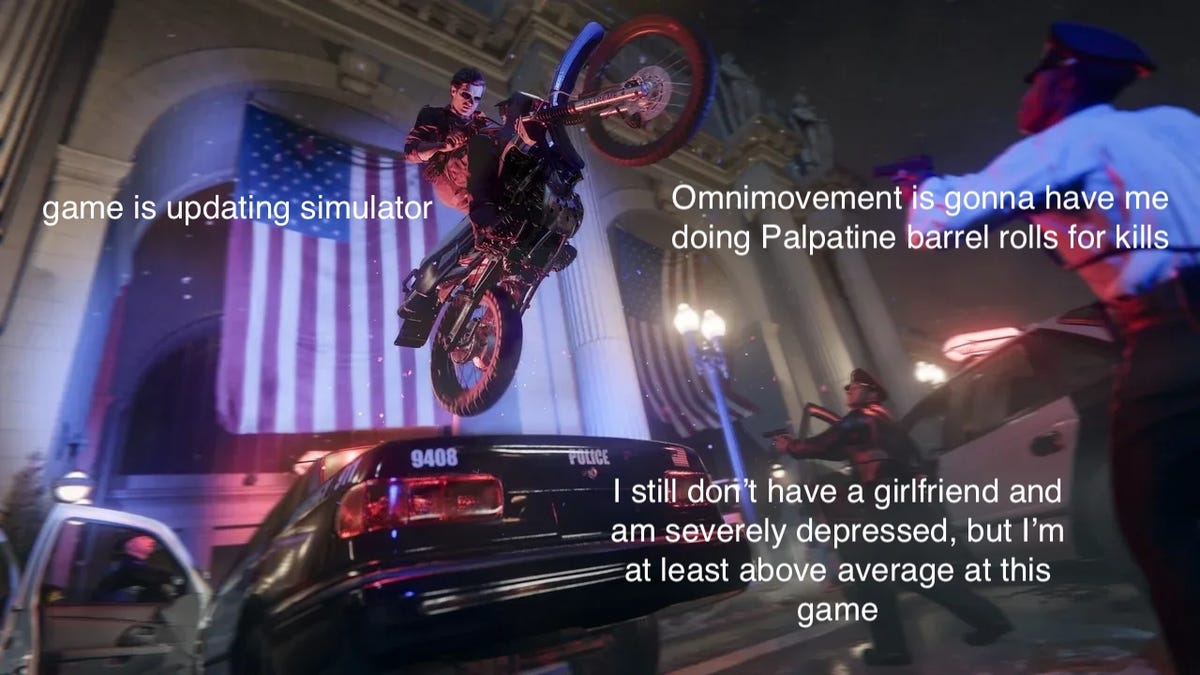
Black Ops 6, As Told By Steam Reviews
Call of Duty: Black Ops 6 is, understandably, a pretty big deal. The franchise has been in a bit of a lull lately, despite routinely setting new sales records, and this game especially needed to be a slam dunk given its unique position. As the first Call of Duty game to release on Game Pass following Microsoft’s purchase of Activision—which itself has been followed by numerous disastrous layoffs—Black Ops 6 has been touted as a return to form for the series, as well as for its embattled publisher. The status of its probable release on Game Pass was debated for months until it was finally confirmed, and now it’s Microsoft’s single greatest chance to bolster the stagnant subscription service and make good on promises.
Order Call Of Duty: Black Ops 6: Amazon | Best Buy
Recent installments in the franchise like Modern Warfare III, Vanguard, and Black Ops Cold War have been met with a decidedly more tepid reception than, say, 2019’s Modern Warfare or even the battle royale game Warzone. It almost seems like with every new entry of late the series has strayed from the desires of its outsized and fairly casual audience. Call of Duty is, after all, one of those games that most people pick up once a year and play till the next one comes along, much like a sports game. Folks who play those games tend to want refinements of core principles rather than drastic or convoluted reinventions.
All of which is to say, Black Ops 6’s return-to-basics approach was a welcome bit of news among the cacophony of showcases, directs, and overbearing blog posts about why this game would be the best Call of Duty ever. After MWIII’s flop of an open-ended campaign, Black Ops 6 doubled down on having a cinematic, blockbuster story mode like the best in the series have offered. Its iteration on Zombies feels like a healthy mixture of new and classic features and mechanics. Even the multiplayer feels sensibly pared back, and it restores tenets that fans have missed, like the prestige system. Treyarch and Xbox clearly want us to think that Call of Duty is “back,” but is it really?
According to the reviews that Black Ops 6 is accruing on Steam, the answer’s a bit more complicated than a simple yes or no. Fans seem to generally agree that the campaign here is better than average, and some are even calling it the best story mode in a COD game in years. And of course there are players who have cherished the simplified renditions of both the competitive multiplayer suite and the cooperative Zombies mode, myself included. As is always going to be the case with a series this big and this polarizing, though, the more you look, the more people you’ll find who are disappointed in some of the game’s features.
One of the biggest problems many seem to have with Black Ops 6 actually has little to do with the game itself and more to do with the packaging, specifically the launcher, Call of Duty HQ. While the tool has been reworked since its initial release, it isn’t significantly better, and it seems to be even worse on PC, where fans of the series seem to hate it more than I do! One review joked that Black Ops 6 is actually a “game is updating simulator.”
Elsewhere, Black Ops 6’s various modes are causing division. Some are appreciating their time with the competitive multiplayer suite, but there are also repeated mentions of terrible maps and spawns throughout the reviews. Having played the beta extensively, as well as jumping in after launch, I can kind of agree that there don’t seem to be any unilateral winners among the crop of multiplayer arenas available right now. Zombies has enjoyed a more positive reception than multiplayer, but still there are players who are unhappy with the settings and crying out for more ambient (spookier) maps in the future.
Overall, Black Ops 6 seems to be earning its “Mixed” reception on Steam. It isn’t the greatest game, but it’s a perfectly fine and fun middling title, and that’s about all I need from it to have a great time. The divisiveness surrounding the game is at least producing some good material in the Steam reviews page, though, so read it and weep.

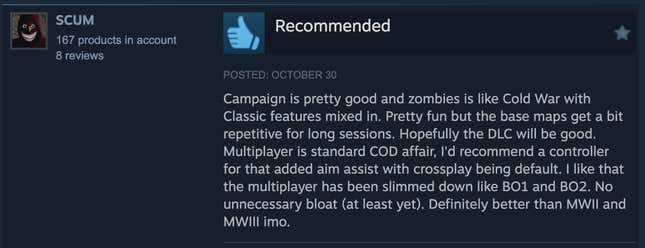








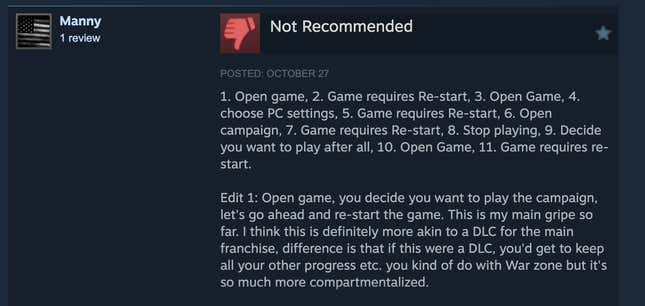

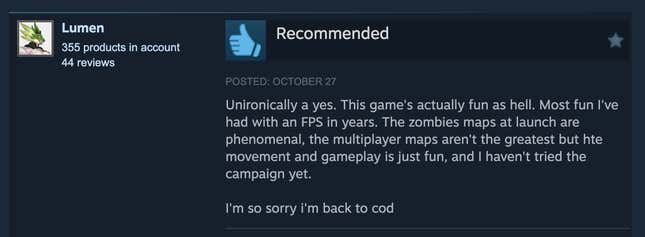
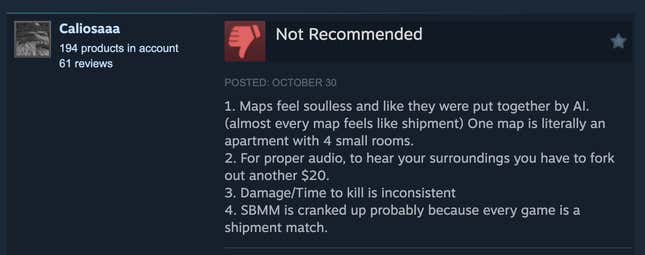




Agatha All Along’s Finale Ends The Marvel Show With A Whimper
Just in time for Halloween, Disney’s witchy series Agatha All Along has concluded with a two-part finale. Prior to this week, the show (which stars Kathryn Hahn, Joe Locke, and Aubrey Plaza) has consistently delivered some of the best Marvel television we’ve seen, with exciting twists rooted in emotional stakes. It’s a huge disappointment, then, that just one week after its best episode, Agatha All Along concludes with a fizzle.

With Lilia’s sacrifice in last week’s episode, the surviving members of the coven find themselves at the end of the Witches’ Road. The only thing standing between the surviving trio and having their greatest desires granted is one last trial and the looming presence of Agatha’s newly revealed ex, Death (Plaza). The first half of the two-part finale focuses on this trial, which asks the witches to make something grow in a concrete and metal enclosure bereft of life.
Despite having twice as long to tell the end of its tale, however, Agatha All Along rushes through the end of the Witches’ Road. This results in Jen, whose story about being mysteriously bound a century ago has been teased for several episodes, getting a quick bow tied to her whole arc and being sent away with little fanfare. It’s a deflating moment, as the show has implied that this is some big thing waiting to be revealed, but when the only revelation is that Agatha accidentally bound Jen in the past for some quick cash, it goes nowhere and the two resolve their differences in a couple of minutes. Jen has never been one of the strongest characters on the show, and concluding her arc with this haphazard ending a week after Patti LuPone delivered the show’s best performance in its defining episode is a major misstep.
Once Jen is out of the picture, Agatha All Along is free to refocus on its greatest aspect, the relationship between Agatha and Billy. With death seemingly imminent for the two as they can’t pass the trial, Agatha is able to help Billy connect with his powers and discover where his lost brother is, thus fulfilling the wish that led him to the Witches’ Road and sending him to safety, leaving Agatha alone to die. This moment also leads to the show’s most gut-wrenching revelation: Agatha’s son wasn’t sacrificed by her on the Witches’ Road at all, he just died. When Kathryn Hahn quietly tells Billy that sometimes boys just die, it’s a heartbreaking confession that there is no power in the world that can keep death away.
But as this is a Marvel property and we aren’t even through the first half of this finale yet, we can’t end on that emotional note. The climax of part one devolves into another special-effects-heavy brawl as Death and the team of Billy and Agatha fire different colored magical blasts at each other. Until now, Agatha All Along has largely steered clear of action, instead choosing to focus on interesting puzzles the coven has to face in each trial. Trading all that originality in for action that makes your eyes glaze over just made me wish the show would end as quickly as possible.
Thankfully, the show comes to an end quick enough. Agatha chooses to sacrifice herself in order to save Billy, which she does by sharing a passionate kiss with her longtime lover, Death, that immediately leads to Agatha keeling over and dropping dead. It’s nice that we actually got a kiss between Plaza and Hahn in the show as they’ve played their characters as explicitly queer, but it’s almost laughable that Agatha is killed off immediately after this display in what has to be one of the most eye-rolling cases of “kill your gays.” Oh, and we actually have a whole other episode to get through!
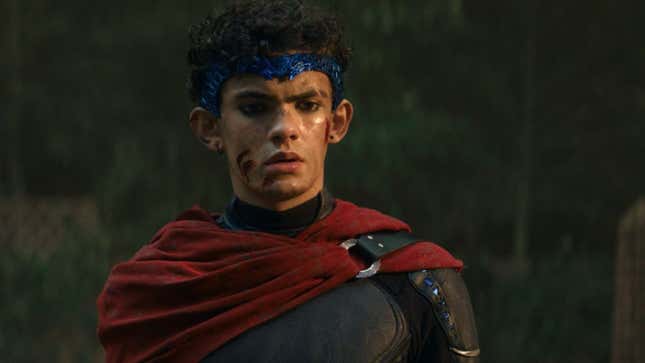
You might wonder what there is left to wrap up, the show’s titular character just died! But part one ends with the reveal that the Witches’ Road was conjured into existence by Billy’s powers unconsciously turning his dreams into reality. It’s a reveal that fans had already clocked, but one that still feels like a cheap trick that does nothing but take away meaning from what has largely been an excellent show.
Yet before we even get to that, the last episode of Agatha All Along begins with a lengthy flashback that reveals the story of Agatha’s son, Nicholas. It turns out that the boy was fated to die in childbirth, until Agatha pleaded with her lover to spare his life. All deals have a price, of course, and Death warned Agatha that his time would still be limited. Naturally Agatha and Nicholas live a fairly happy life for a few years, until one night Nicholas dies in his sleep. What’s supposed to be a window into Agatha’s soul at her most vulnerable, however, feels instead like padding to a finale that has already overstayed its welcome. Marvel projects, on both the big and small screens, seem to think subtlety is the enemy. This is just another example of that mentality, as the single quiet moment between Billy and Agatha in the first part of the finale contains exponentially more meaning and power than this extended sequence. Instead of “show, don’t tell,” Marvel chooses to show and show and keep showing until they’ve beaten you over the head with the awareness that this should be sad. A parent outliving their child is inherently tragic, of course, but stretching this emotion to its limit has diminishing returns.
As its final and grandest reveal, Agatha All Along reframes everything we’ve seen before in a much poorer light. Rather than really being a show about Agatha, this is first and foremost Billy’s show. The deaths of every other coven member (minus Jen, who survives) are just footnotes in his origin story. To justify the show’s choices, Agatha appears to Billy to act as his debate partner one more time, now in the form of a ghost—perhaps the most egregious example yet of Marvel so clearly being unwilling to commit to killing off a fan-favorite character despite the death it wrote them into. Like the show has stated before, this whole journey just shows that Billy is a killer just like his mother, one who is unable to control his dark powers. Just like the dead coven members who are nothing more than fodder for Wiccan character growth, the entirety of Agatha All Along feels like one more Marvel project that isn’t meant to stand on its own but is instead fodder for the grand MCU machine.
.

How To Unlock The Secret Ending
Dragon Age: The Veilguard wraps up a lot of ongoing storylines for fans of BioWare’s fantasy RPG series. But it also has some new threads to pull on, one of which is the focus of the game’s secret post-credits stinger. Unlocking this final revelation is a hefty affair that will span several quest lines. If you want to see everything The Veilguard has to offer, here’s a spoiler-free guide on how to unlock the secret post-credit scene. We’ll go over the requirements first, then we’ll throw up a spoiler warning and talk about what it all means.
How to unlock Dragon Age: The Veilguard’s post-credits ending
One of the lengthy quest lines you’ll have to complete to see The Veilguard’s post-credit scene is tracking down the wolf statues in the Crossroads. These figures unlock some massive lore bombs and backstory about Solas, the elven god at the center of The Veilguard. You’ll find these behind locked areas in the Crossroads, which will often require you to fight a mini-boss or solve a complicated puzzle. Once you’ve found all five, you’ll have a visitor in the Crossroads who will direct you to the final stage of the quest line, which can unlock another choice in the game’s finale. However, that’s not all that’s required to unlock the secret ending.
You’ll also need to find three “Mysterious Circles” hidden around Thedas. These are artifacts that are tucked away in dangerous places that are only accessible after you put in some work. One is in Arlathan Forest and requires you to complete an elaborate laser puzzle that builds a bridge to some ruins surrounded by a lake you can’t swim through.
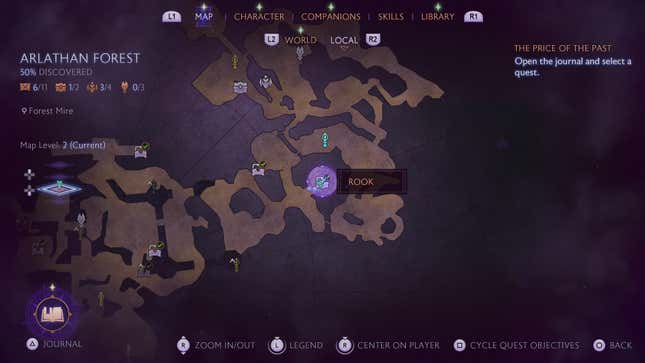
The other two are hidden behind dragon boss fights. One is in the Necropolis where you recruited Emmrich. The region is home to “The Formless One,” which is a dragon you’ll fight by completing the quests “Restless Spirits” and “Pinnacle of its Kind.” You’ll find one of the Mysterious Circles in the southwest corner of its lair.
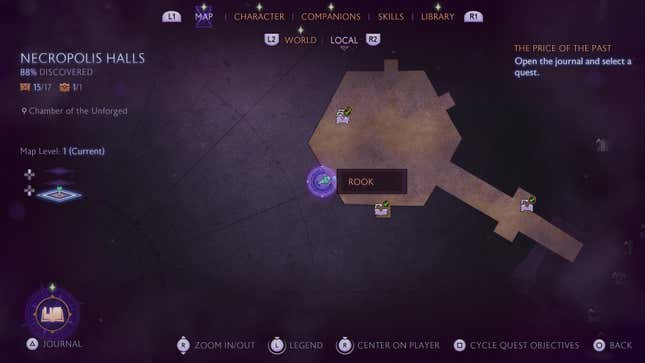
The last is perhaps the most involved of the three. This one you’ll find in the lair of a dragon in the Crossroads as part of the quest “The Heart of Corruption.” This requires you to fight three high-level champion mini-bosses throughout the Crossroads who are siphoning power from tears in the Fade. Each champion defeated gives you a key to unlock the dragon’s lair. Once you defeat the beast (a task made easier once you’ve found all five of the wolf statues), you can find the Mysterious Circle stashed away in a hidden passage south of the dragon’s arena.
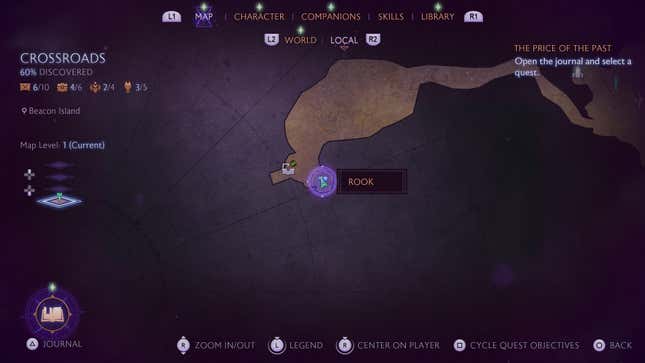
Then, all you’ve gotta do is reach the end. We won’t dive into The Veilguard’s finale here, but we will dissect the short post-credits scene below. So if you don’t want to know what it entails, skedaddle.

Are they gone?
Okay.
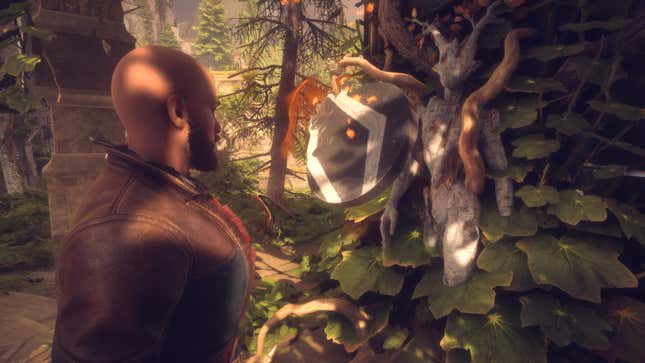
Dragon Age: The Veilguard’s secret post-credits scene, explained
The brief, one-minute clip you did all that work to unlock has a lot of wide-reaching ramifications for the Dragon Age series. It depicts art of several key events of each game in BioWare’s series, but with cloaked, shadowy figures inserted into them. This includes the Battle of Ostagar in Dragon Age: Origins that led to the loss of most of Ferelden’s Grey Wardens, Bartrand’s stealing of the Lyrium Idol in Dragon Age II and setting off a chain of events that resulted in the Mage-Templar War, and Corypheus’ opening of The Breach in Dragon Age: Inquisition and nearly destroying the world as we know it. The voiceover from a devilish, unknown individual recounts how their group has “balanced” and “guided” the people of Thedas in one way or another, resulting in the events of previous games. To what end? That’s unclear at the moment. But what is clear is that this voice and these shadowy figures are part of the Executors, an enigmatic group that was first hinted at in Dragon Age: Inquisition, then further expanded upon in the anthology book Tevinter Nights.
In Inquisition, you set up several bases throughout the world of Thedas, and eventually, you’ll receive a war table operation that tells you symbols drawn in chalk have started appearing on those bases depicting a downward-pointing triangle covered by two wavy lines. This symbol is shown at the very end of The Veilguard’s post-credits scene as the voiceover says, “We come.” This entire scene seems to imply the Executors have been putting their plans into motion by manipulating characters like Loghain and Bartrand throughout Dragon Age. Whatever they’ve been working toward is finally coming to fruition, and they are coming to Thedas in the near future.
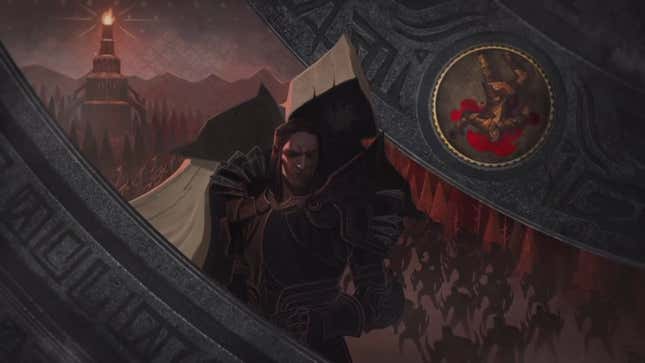
The art we see of Executors in this scene matches the descriptions in Tevinter Nights, which says they are hooded, robed figures. But we also know them to be from “across the sea,” meaning they come from a land beyond Thedas and represent some force we’ve not encountered yet in the Dragon Age series. The codex entries that you receive from the Mysterious Circles imply they could be followers of the Forgotten Ones, the disgraced elven gods who have been mostly erased from history. Given that one of the only known Executor characters was shown opposing Solas in Tevinter Nights, this seems like a possible explanation that could be further explored in a future game, given that The Veilguard takes most of the elven gods we knew of off the board.
Even outside of this secret ending, there are references to some dangerous force from across the sea in The Veilguard, such as when Taash is given a warning about them in their personal quest. Will current hero Rook be the one to fight these forces when they come knocking, or will the next Dragon Age game keep the series’ long-running tradition of bringing in a new protagonist? The Veilguard does end with a Marvel-style “The Veilguard remains vigilant” text right after this revelation which, to me, reads like a subtle implication that Rook might be leading the fight. But hey, Inquisition ended with a much more direct scene that The Inquisitor could face Solas in this game, and that didn’t happen. So we’ll have to wait and see.
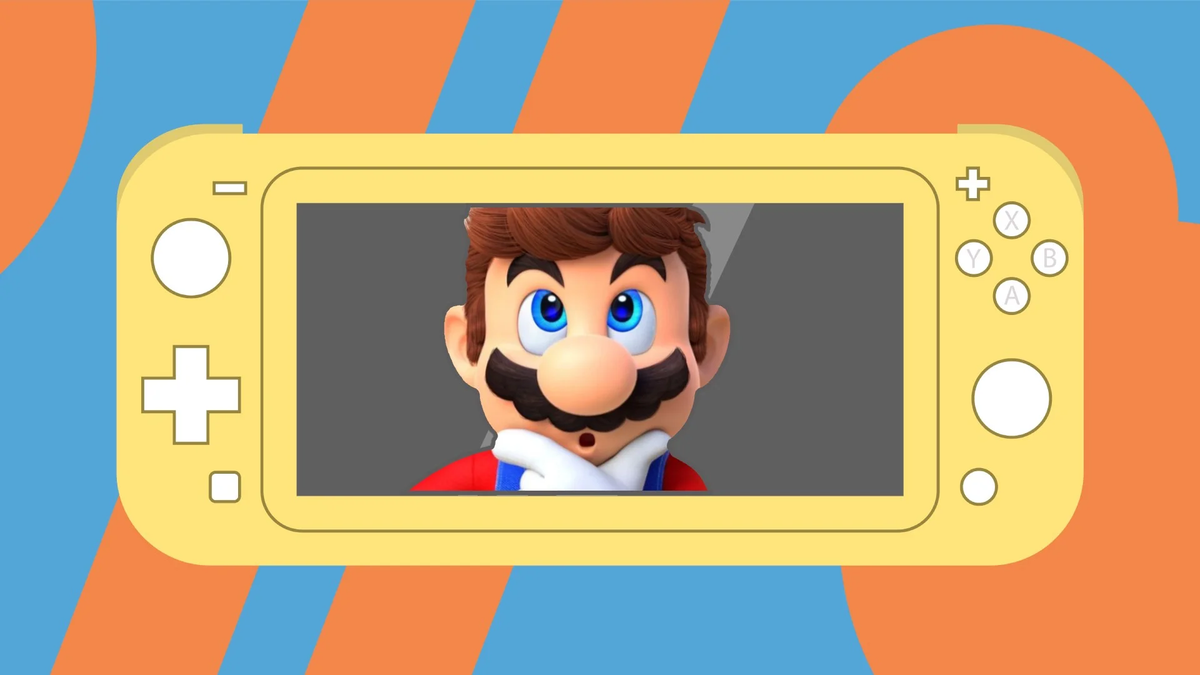
Nintendo Keeps Announcing Things That Aren’t The Switch 2
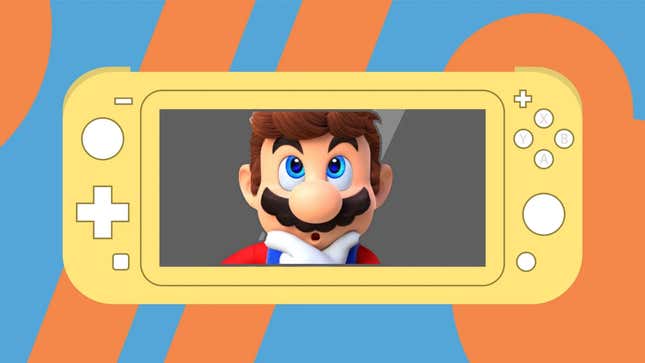
Where the hell is the Switch 2, folks? It’s the last day of October and Nintendo still hasn’t revealed the one thing every fan is waiting for. Instead, we’ve gotten almost everything else the company could think of, from random ports of cult Wii U games to literal alarm clocks. What else could the gaming giant throw at fans while it continues running out the clock on a new console announcement in 2024?
The signs were there, from mysterious leakers to the company’s own president. “We will make an announcement about the successor to Nintendo Switch within this fiscal year,” Shuntaro Furukawa tweeted back in May. Technically, Nintendo’s fiscal year runs until March 31, but my god, man! Give us a single image of the hardware, an official name, anything! Five months later, fans have survived heart-stopping levels of hype ever since the company ditched its regular September Nintendo Direct and chatter from developers and others about an imminent announcement reached a fever pitch.
With all eyes on the mustachioed plumber, the console manufacturer decided on a different course of action. Instead of revealing the Switch 2, Nintendo announced Alarmo, a $100 device that uses video-game sounds to get you out of bed, at least if you’re single. We got a mysterious online playtest announcement that turned out to be for a weird MMO. On a random Tuesday, Nintendo decided to drop the news that niche Wii U exclusive Xenoblade Chronicles X would all of a sudden, 10 years later, arrive on Switch next spring. And then last night the company busted out even more news: Nintendo music now has a standalone app for smartphone listening as part of Switch Online.
It now feels like time is running out for Nintendo to actually reveal the Switch 2 before the end of 2024. Maybe there’s a small pocket of time in November before the holiday, but why would the company decide to steal thunder from Mario & Luigi: Brothership or its big holiday push to help sell another 10 million more Switches this year. Maybe Nintendo just does not give a fuck anymore, confident in the knowledge that, whenever it chooses to announce its next console, the news will bend the attention economy to its will no matter the manner or timing in which it unfolds. Or maybe this means we really aren’t getting a Switch 2 reveal before mid-January after the holiday break.
In the meantime, here are nine more things I would be less shocked to see Nintendo announce between now and then that aren’t a Switch 2.

Should You Save Minrathous Or Treviso
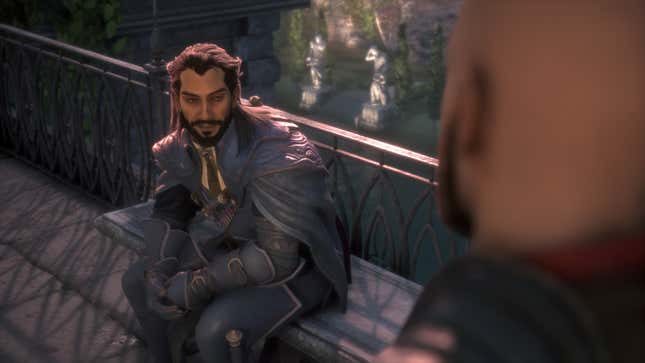
Many of Dragon Age: The Veilguard’s choices are personal and focus on your team’s relationships and life paths. However, one of the big, world-changing ones comes early on, shortly after you recruit Davrin, the Grey Warden companion. Right now, you might be staring at a choice between helping either the Tevinter city of Minrathous or Treviso, the home base of the Antivan Crows, from coordinated dragon attacks. If you’re unsure of what decision to make and want to know what the results of each option are, we’re here to lay them out for you.

This choice has an impact on your party and your faction allies, as both the Tevinter mage Neve and the Antivan assassin Lucanis are from the affected cities. You’re essentially making a choice on which city and faction will be in a better position to help you when the time comes, and putting Neve or Lucanis on a specific path in their stories and even combat roles. Here’s the rundown of the consequences.
- The person you don’t help will temporarily leave the party
- When they return, they will be considered “hardened,” which locks out parts of their skill tree and makes it harder to progress their relationship without higher approval throughout the game
- You will lose some choice in Neve and Lucanis’ personal storylines, and they will be forced to go down one direction because of the circumstances
- The city you don’t save will be blighted, altering quest lines and dialogue, and cutting off access to the local faction’s shop
- The Shadow Dragons or Antivan Crows will have a baseline loss in allied strength points, meaning it will be impossible to max them out
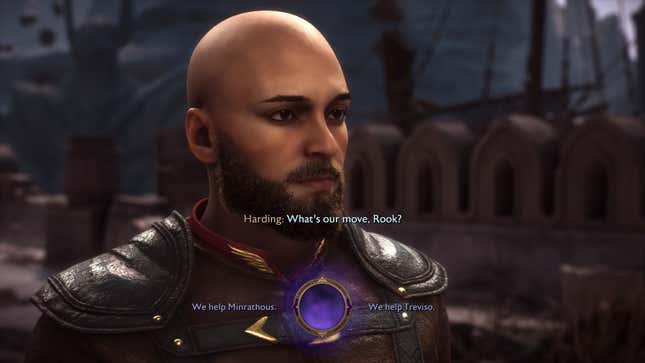
Overall, it’s still a binary choice that evens itself out, but it will have pretty direct ramifications on your relationship with Neve and Lucanis above all else. It’s still possible to reach the end of their storylines (including having them become a Hero of the Veilguard, which is the equivalent to reaching maximum Loyalty in the Mass Effect series) and make up for the loss in allied power, but it will take more sidequests to make it happen, and you won’t have the shop to sell valuables to in order to juice those numbers.
What I’m unsure of as of this writing is whether or not it locks you out of Neve and Lucanis’ respective romances. I saved Minrathous in my playthrough and my relationship with Lucanis was slow to progress for a bit, so I didn’t see any further options to flirt and eventually locked in my romance with Davrin. We’ll update this guide as that becomes clear.
If you’re reading this guide, you’re probably a decent way into The Veilguard, but if you’d like a few extra tips to help you as you take down the elven gods, we’ve got those, too.